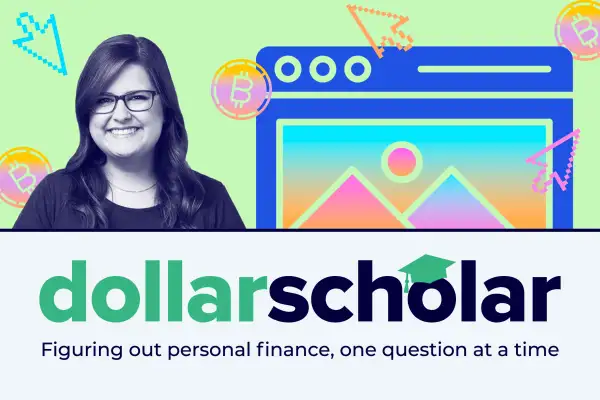Dollar Scholar Asks: Whatever Happened to NFTs?
Money is not a client of any investment adviser featured on this page. The information provided on this page is for educational purposes only and is not intended as investment advice. Money does not offer advisory services.

This is an excerpt from Dollar Scholar, the Money newsletter where news editor Julia Glum teaches you the modern money lessons you NEED to know. Don't miss the next issue! Sign up at money.com/subscribe and join our community of 160,000+ Scholars.
Remember NFTs?
A few years ago, non-fungible tokens were an absolute phenomenon. It seemed like every celebrity had one: Gary Vaynerchuk invested $32.6 million into 59 CryptoPunks; Justin Bieber purchased a Bored Ape for $1.29 million. Mark Cuban created a digital art gallery specifically to display his NFTs, and Liam Payne started a separate Twitter account for NFT discussion. Even Dolly Parton got on board.
NFTs were inescapable — and then, all of a sudden, they weren’t. According to a September report from crypto gambling platform dappGambl, 95% of NFTs are now worthless.
Record scratch.
Whatever happened to NFTs?
Bina Ramamurthy, a professor at the University of Buffalo and author of Blockchain in Action, says the NFT bubble burst largely due to supply and demand.
Though the first NFT was invented in 2014, they didn’t really take off until after the GameStop short squeeze in 2021, when much of the U.S. was in pandemic-induced lockdown. Bitcoin hit a new high, and Christie’s sold an NFT piece by digital artist Beeple for $69 million. Excited creators learned how easy it was to make their own NFTs, and soon “there was a deluge,” Ramamurthy says.
It's easy to see why. Especially in the collectibles space, NFTs offered a ton of perks and relatively few drawbacks (among them volatile pricing and environmental impact). And, crucially, the potential financial kickback was huge, says Alex Rawitz, COO of Digital Infrastructure Inc. and cofounder of DIMO.
“The key business model for all the people creating these NFTs was, in the few clicks of a button, create a whole ton of images and sell them to everyone for 10 bucks to 100 bucks to 1,000 bucks,” he adds. “You can make millions of dollars pretty quickly.”
For a while, as supply exploded, so did demand. Because NFTs are unique ownership tokens that are linked to the blockchain, buyers generally had to use cryptocurrency in order to buy them. Most people who had a lot of crypto at the time tended to be wealthy early adopters with money to burn, inflating prices, according to Isaac Patka, co-founder of Shield3 and GLITCH residency NFT artist.
These buyers were enchanted by the idea of a digital record that proved ownership and authenticity, leading to the illusion of scarcity. Rawitz says a few NFT collections started to accumulate value, and people took notice. Speculators bought into the next NFT simply because they’d missed the last one (and because purchasing them was as simple as tapping on their iPhone from the couch).
Before long, regular people were priced out of NFTs, and things spiraled out of control.
“Everybody spun up an NFT for their own project,” Ramamurthy says, and soon “nothing [was] special about it anymore.”
The glut of supply meant that the underlying intellectual property wasn’t as precious as buyers had once thought. Many of the benefits of NFTs, like artists being better able to access royalties, didn’t materialize. Supply outpaced demand in a major way, and value cratered.
“Like all frenzies, I think people just lost a lot of interest,” Patka says.
Now, according to dappGambl, 79% of NFT collections are still unsold. An estimated 23 million people hold worthless NFTs.
Despite this, the experts insist NFTs are not dead. Ramamurthy says that technological developments tend to come in waves, so we’re likely to see an NFT rebound at some point — maybe in real estate, as land ownership involves a finite quantity of a physical object with perpetual value.
“With time, people will wake up and see NFTs are not for whimsical things; they have to have a purpose and problem-solving ability,” she adds.
Rawitz says the next evolution of NFTs must go “beyond the Pokemon cards I keep under my bed.” It has to provide tangible perks for everyday buyers, like if purchasing a Taylor Swift NFT gets me special tickets for her next tour. There are also opportunities in the IP space — just look at Pudgy Penguins, a collection of cute NFT characters sold at Walmart as IRL stuffed animals.
The crucial difference from 2021? These sorts of NFT projects go way beyond get-rich-quick schemes, according to Patka: “The level of artistic experimentation in the NFT space is actually increasing even though the public interest has faded,” he adds.
The bottom line
The NFT bubble burst because of an imbalance in supply and demand. But while the vast majority of 2021 projects are now worth very little, the industry isn’t dead. It’s pivoting and innovating. The next stage of NFTs are focused on real-world value for creators and buyers alike.
“Anything that facilitates new connections and communities and [allows] people to geek out on stuff together — people will naturally continue to do that,” Patka says.
More from Money:
Only 1 in 4 People Actually Know What an NFT Is

